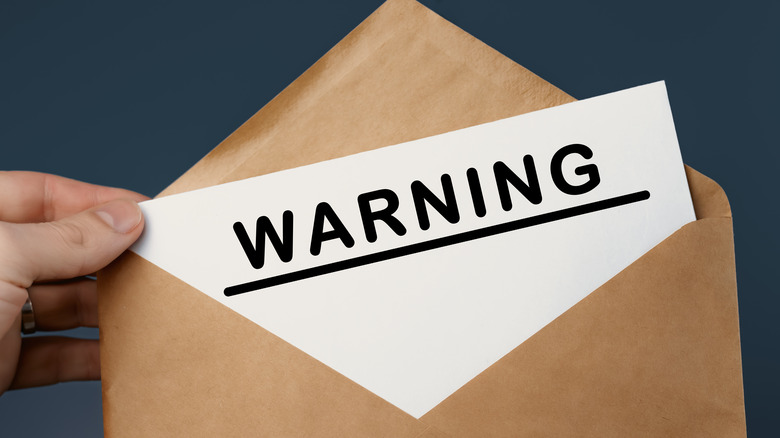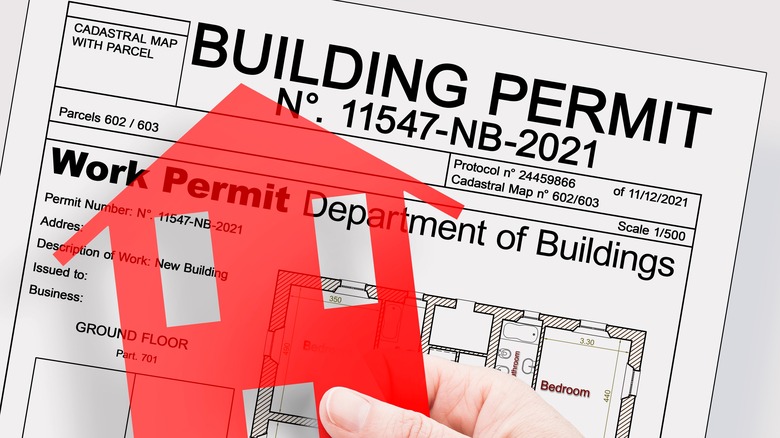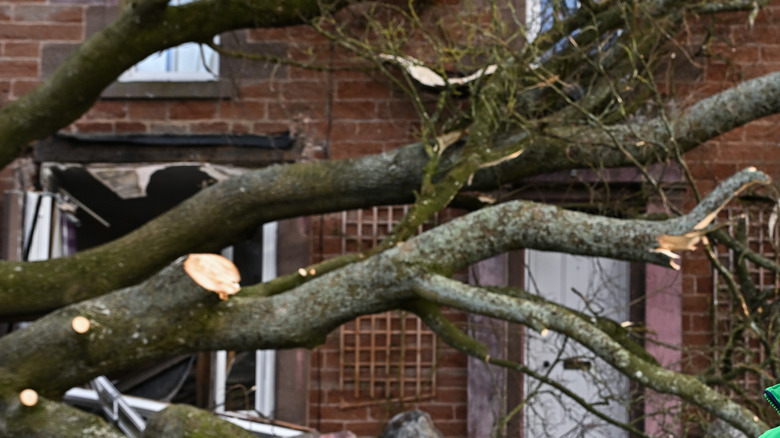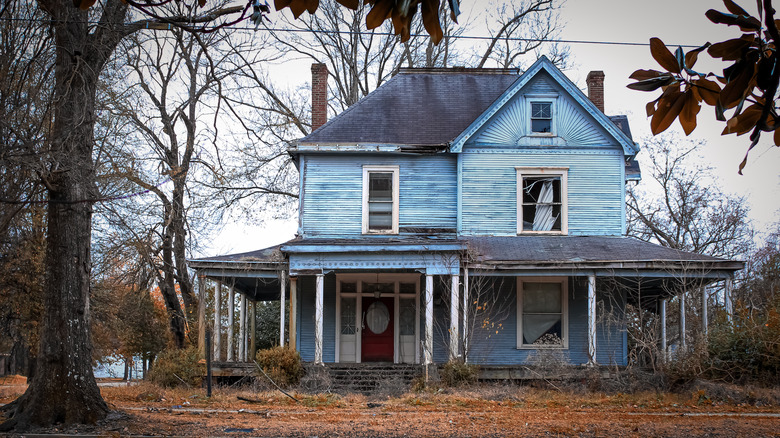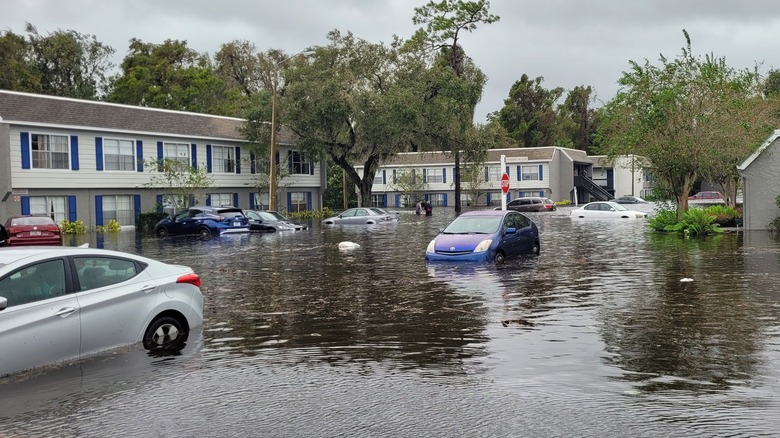Every Important Term You'll Find On A Seller's Disclosure Explained
Buying or selling property can be a daunting, overwhelming endeavor filled with real estate jargon, legal hoops to jump through, and sometimes even people trying to pull one over on you as a buyer or seller. As a buyer, you have a journey ahead of you, from viewing properties to signing on the dotted lines. Before packing up and moving in, there are many things to consider, but one of the most important is the seller's disclosure form. The seller's disclosure form is a document that tells you everything you need to know about your new home, with a special focus on the house's issues.
On the seller's side, this form is a way to offer the potential buyer inventory of the property, from how old it is to all known damages. This document is shared to avoid legal trouble, proving they have shared all the house's issues (via NerdWallet). In real estate, there are a few types of disclosures that will come up, many of them self-explanatory. These include natural hazards, death in the home, and nearby nuisances (via Rocket Mortgage). However, some aren't clear, such as the caveat emptor, market conditions advisory, and state and local transfer disclosures. More confusing, many of these laws and disclosures are required by some states and not others, so you will need to investigate, depending on which state you live in or are moving to. For example, Alabama, West Virginia, and Wyoming are caveat emptor states, while Massechuessets, for instance, emphasizes lead paint disclosures (via Home Light).
All of these rules can make the seller's disclosure document feel more complicated than it is, but thankfully it doesn't have to be. Here, we will highlight some complicated wording you might find in the document and break them down into much simpler terms. And you'll find some of these phrases are just fancy ways of saying very literal things.
Caveat emptor and caveat venditor
So what exactly does caveat emptor — a Latin phrase — mean? In English, it means "buyer beware." This dramatic, ominous warning isn't as scary as it seems. It essentially means that the buyer is purchasing the property at their own risk. It relieves the seller of any responsibility for the house's condition. On the other side is the caveat venditor, which advises the seller to "beware." This emphasizes that the seller can be held liable for any damages not disclosed to the buyer (via Rocket Mortgage). Seeing one of these phrases in the seller's disclosure lets you know how protected or unprotected you are during the purchase.
Recently, the caveat venditor has slowly taken over from the emptor as more laws seek to protect buyers from dodgy home sales. In July 2020, the Consumer Protection Act was updated from its 1986 predecessor. This newer act officially rejects the idea that the seller bears no responsibility for any issues with the product or service they are selling, therefore ushering in a new era for consumers (via Nickled and DImed). Great news for buyers across the board, but particularly favorable for first-time buyers who may have otherwise been shorted in their purchase.
Land-use limitations
As the name suggests, this law controls how you use your land and limits what you can change on your property (via ThisMatter). Seeing this in your disclosure means you have restrictions on what you can do with your house, and it will outline what rules you need to abide by while living there. For example, if you want to extend your home by adding a loft or a conservatoire, you may come up against restrictions that dictate how much you can do. This is known specifically as a deed restriction, and it keeps owners from increasing the number of people on their property (whether renters or in-laws), and limits aesthetic changes to the neighborhood.
If you are buying a historical building, the land-use limitation will include acquiring permits in order to get any changes approved by the historical society or local government. These controls also include building codes, subdivision regulations, tree-cutting laws, property easements, and outstanding liens. They aim to prevent any property development disorder and maintain the quality of residential and public properties.
Megan's law disclosure
In 1994, a 7-year-old girl, Megan, was assaulted and murdered by a neighbor, who, unbeknownst to her family or other residents in their New Jersey suburb, was a convicted sex offender. Months after this gruesome crime, a law was introduced that demanded that any sex offenders must register with the local police in their neighborhood. Police, in turn, inform communities (via Building Better Agents).
This is one rule that must be included in seller's disclosures in every state across the nation. If you see this disclosure statement, it means there is such an offender in your neighborhood. However, this rule can only be enacted if the real estate agent or seller is aware that a sex offender lives in the area (via Victor Insurance). However, if the seller or their agent consciously omits this information from their disclosure, and the local authorities then inform the buyer, the buyer may be able to file a lawsuit against both seller and agent for excluding vital information that would have potentially impacted the sale.
Encroachment of land issues
This one's a biggie, but fear not; it's pretty easy to explain and could save you a lot of headaches when considering your buying or selling options. Encroachment of land occurs when a neighbor infringes upon another property that does not belong to them. When this happens, a boundary is — literally — crossed (via Jules Martin Haas).
So why is this important to disclose in a seller's form? Things can be sorted relatively straightforwardly in minor cases, like overgrown hedges leaning over the fence. However, things can become a bit more complicated when dealing with infrastructural boundaries being crossed, such as building extensions that cross over into a neighbor's property or constitute a nuisance in some way. If this is shared in the seller's disclosure, you are being warned that you might have to deal with this property line encroachment in the near or far future, and that you may be liable for the changes or damages.
Polybutylene pipes disclosure
Polybutylene pipes were discontinued in 1995 following a number of plumbing issues that arose from their use (via Benjamin Franklin Plumbing). Although they were initially hailed as a breakthrough in piping when they were first introduced in 1978, they fell out of favor when complications arose. For example, when they interact with chlorine in the water, micro cracks appear, eventually forming fractures.
So when it comes to a seller's disclosure, highlighting that the property still maintains its polybutylene pipes from the '70s, '80s, or '90s may be a crucial piece of inventory to avoid legal ramifications (via Pip's Island). And if you see this on your disclosure form as a buyer, you'll know you might have some hefty plumbing replacements in your near future if you choose to purchase this home. From the seller's perspective, how does one sell a house with out-of-date plumbing materials? It is indeed possible to do, albeit a bit of a challenge. One option is to sell the home "as is." This means that the seller presents the home to potential buyers with all its flaws and complications, and it is up to the buyer to accept the property as it is (via Adobe).
Neighborhood nuisance
Have you heard of the Law of Nuisance? No, it's not a heavy metal band coming to a city near you. The Law of Nuisance refers to a legal complaint against a neighbor creating a hostile environment through their actions (via FindLaw). Encroachment, which we touched on earlier, is one example. But generally, there are two types of nuisances: public and private. According to Cornell Law School, when something is categorized as a public nuisance, it affects the larger population of the neighborhood or community. It is a hazard to a group of people's comfort, safety, and health.
However, a private nuisance is often a public nuisance that adversely affects one individual or a household. For example, noise pollution from a neighbor may constitute a nuisance for several neighbors on the street. Still, for the individual or people living next door, it may cause a bigger interference to their comfort. As with all terms and phrases on this list, a disclosure form must include anything that may affect the home's value. Therefore, it is a legal requirement to declare any neighborhood nuisance in a seller's disclosure form. A buyer can sue a seller or agent if they become aware that longstanding nuisances were intentionally left out of the disclosure form, as this is seen as an omittance of truth (via Orchard).
Stigmatized property
Want to hear a scary story? A couple bought their dream home, but before they could move in, creepy letters began to come in the mail. Soon the young family was being threatened by a phantom neighbor who seemed chagrinned that they had moved into the property. For years, the couple enlisted the police, other neighbors, and even the press to try and locate the source of these increasingly menacing letters — all to no avail. Soon, the property was all over the news; it became a viral article in The Cut and, finally, a Netflix series starring Bobby Cannavale and Naimi Watts (via IMDb). Since word got out about this property's many woes, the real couple has been unable to sell it, rendering it a stigmatized property.
Stigmatized properties are properties marred by a murder, suicide, a previous owner with a notorious reputation, and other stigmatizing events that potentially drive a property's value down (via the National Association of Realtors). So if you see this pop up in a seller's disclosure, you know something nefarious might have happened in your potential house. Many properties tend to lean into their reputation and, by doing so, drive their value right back up. According to The Zebra, one in three Americans claims they would willingly live in a haunted house or a house that has endured any other kind of stigma.
Hazards
In a seller's disclosure form, the term "hazard" does a lot of heavy lifting. It can refer to environmental dangers, natural ones, or even chemical threats that a property is or has been exposed to. Where natural hazards are concerned, risks such as extreme weather, flooding, earthquakes, and the like must be disclosed within the form. States like California, particularly with the increasing wildfires, require sellers to highlight these hazards if the property is vulnerable to them (via Glide).
On the other hand, environmental hazards are an umbrella term for various dangers, from carbon monoxide to lead paint, from asbestos to hazardous waste. While there are currently no federal laws making it illegal to sell a home with mold, states like New Jersey include multiple lines of questioning specific to mold disclosure (via Curren Environmental). If a seller fails to disclose that their property is vulnerable to environmental hazards — whether in the past, future, or present — or is aware that it is faulty and does not declare that information, they can be held liable by the state for omitting crucial information about a possible hazard in the home (via Torii). And if you, the buyer, see one of these hazards on the disclosure form, you'll know that your potential purchase has possible risks.

